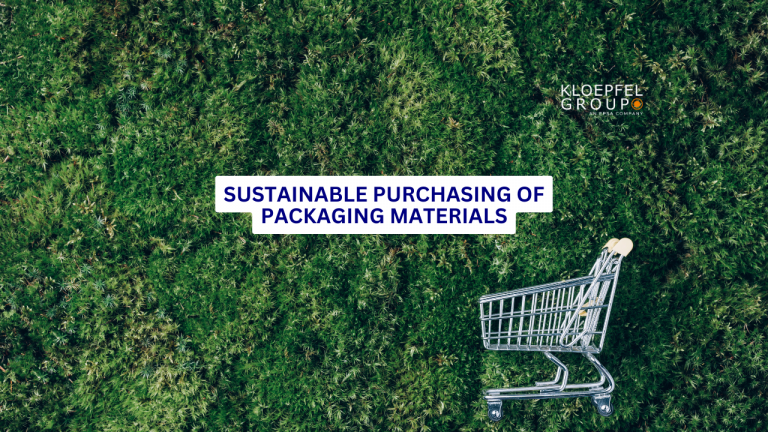Sustainability as a driver of innovation
Authors: Benedikt Benz, Senior Consultant Kloepfel Consulting and Heiko Steinmetz, Sustainability Manager Kloepfel Consulting
Purchasing decisions play a decisive role when it comes to selecting packaging materials. In this guide, we give you an overview of primary, secondary and tertiary packaging materials and concentrate on various focus product groups.
The market for packaging materials is constantly evolving. Sustainability is increasingly becoming the driving force behind innovation. Companies that offer environmentally friendly packaging solutions are well positioned to meet the changing needs of consumers, but also to comply with legal requirements both nationally and within the EU. In Germany in particular, this is regulated by the so-called Packaging Act (VerpackG). This regulates, for example, the ban on single-use plastics, mandatory deposits and minimum recycling rates. Overall, it is crucial that companies pay attention not only to functionality and aesthetics, but also to sustainability when selecting packaging materials.
The trend is clearly moving towards environmentally friendly packaging solutions. Companies that strategically adapt to this at an early stage will therefore be successful in the highly competitive packaging market in the long term.
Packaging materials are generally divided into 3 categories:
Primary packaging:
A primary packaging material is the first or direct packaging layer that directly encloses a product. It is the packaging that protects the actual product and ensures its integrity during transportation and storage. The primary packaging comes into direct contact with the product and is primarily used to protect the product, extend its shelf life and make it easily accessible to the end consumer.
Examples: Bottles, cans, tubes
Secondary packaging:
A secondary packaging material is an additional packaging layer that holds several primary packaging materials or individual products together. Unlike primary packaging, which directly encloses the product, secondary packaging is an outer layer that is often used to facilitate the handling, transportation and sale of the products it contains. It provides an additional layer of protection and organization during the distribution process.
Examples: Outer packaging, boxes, trays
Tertiary packaging:
A tertiary packaging material is the outermost layer of the packaging hierarchy and is primarily used to protect and handle multiple secondary packaging materials during transportation and storage. In other words, tertiary packaging comprises the shipping or transport packaging, which often bundles several secondary packaging materials or products and protects them from external influences.
Examples: Shipping cartons, pallets, containers
Having provided an overview of the different packaging categories and their importance for sustainable packaging, we now turn our attention to the practical side – the procurement of this packaging. Here are some steps and considerations that can help you make sustainable sourcing decisions.
Procurement of bottles and tubes
Plastic bottles and tubes are manufactured using various processes, including blow molding and extrusion. When choosing which process to use, it is important to consider the possible use of sustainable raw materials and recyclates to minimize the environmental impact of the products being manufactured. Companies that focus on the circular economy are increasingly integrating recycled materials into their packaging. Unlike plastic bottles, glass bottles are formed into the desired shape within a melting process at approx. 1,700-2,000 degrees Celsius and are brought to a solid final state by evenly cooling the product.
Generally work with suppliers who are committed to sustainable production practices. Check their environmental certificates and check whether they use recycled materials. Actively negotiate the use of recycled materials to minimize the environmental footprint of your packaging.
In recent years, many companies and start-ups have focused on the development of packaging based on renewable raw materials, such as corn starch, sugar and cellulose, and have thus also brought new trends to the market.
Purchasing cardboard packaging and folding cartons
Cardboard packaging and folding boxes are widely used secondary packaging materials. In addition to qualitative functionality and a desired visual appearance, the licensing and disposal of packaging materials is a very important aspect, also within the procurement and supplier selection process. Certificates such as FSC and PEFC indicate compliance with environmental standards and are an important indicator that the raw materials come from sustainably managed forests. The importance of licensed materials has increased significantly in recent years and tends to be perceived more as a “standard” on the market. There is no lack of innovation in this sector either, which is why it is all the more important to take a holistic approach to optional alternative raw materials.
Finishing of packaging materials
The finishing of packaging materials plays a decisive role in product marketing. Folding cartons, displays, POS materials and dispensers should not only be functional, but also aesthetic and appealing. They are therefore an essential part of sales promotion at the point of sale and also serve to enhance brand recognition and image. Common finishing processes are gloss varnishes, foils or embossing. Two main printing processes are used in the manufacturing process. Economical and high-quality offset printing for medium and large print runs, and inkjet printing for very small print runs or displays.
Both processes offer optimum results on the packaging materials and inkjet printing also enables the use of alternative substrates that cannot be processed with conventional offset printing machines.
When it comes to finishing your packaging, choose the right partners carefully and actively ask about sustainable technologies and the machinery used.
In addition to elaborately finished packaging materials, which are often used for high-priced and exclusive consumer goods, there is a much larger market for product packaging without finishing. The main focus here is on the economical and timely production of large quantities. Depending on the application and requirements, the advantages offered by flexographic and gravure printing are also utilized.
Conclusion
The procurement of packaging materials is a complex process that requires a profound insight into the world of packaging. Successful management in procurement requires not only broad know-how, but also an understanding of current market conditions.
The current market trend in packaging procurement is undoubtedly characterized by sustainability. Companies that offer environmentally friendly packaging solutions are not only in line with growing consumer expectations, but are also well positioned to benefit from regulatory developments. The availability of sustainable materials and working with suppliers that meet environmental standards are key success factors in this dynamic market environment.
In the procurement of packaging materials, it is not only important to react to current market trends, but also to proactively promote innovation. A holistic approach that takes economic, ecological and social aspects into account forms the basis for sustainable and future-oriented packaging procurement.
Make an appointment with us if you need support in purchasing sustainable packaging materials.
Our broad expertise in this area enables us to accompany you on the way to efficient, sustainable and competitive packaging solutions.
Autoren:
Contact:
Kloepfel Group
Christopher Willson
Tel.: 0211 941 984 33 | Mail: rendite@kloepfel-consulting.com




